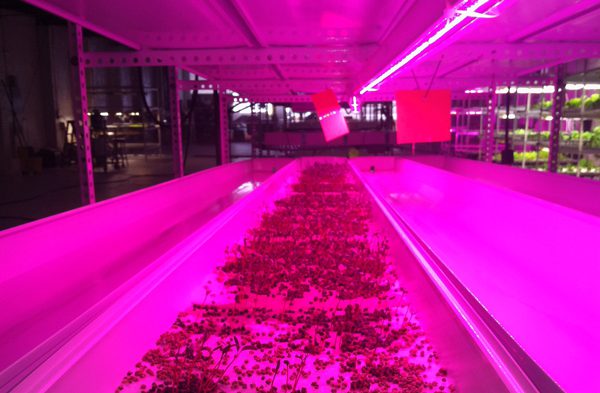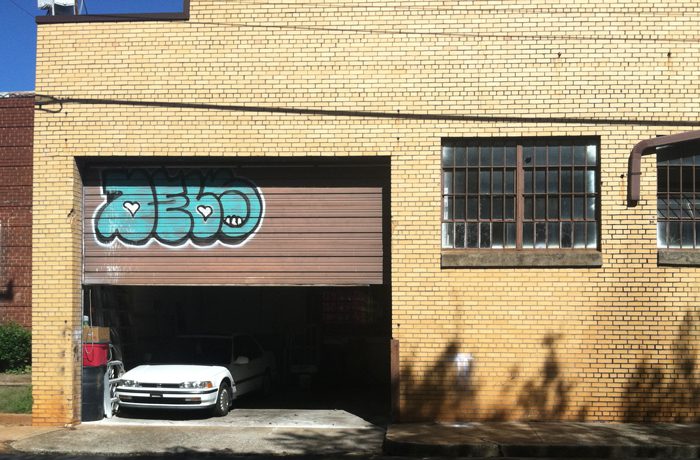Growing greens indoors to boost local foods, job skills

Just northeast of uptown Charlotte in the Tryon Hills neighborhood, in a previously abandoned and cluttered warehouse, is Lila’s Garden. There is graffiti on the entrance, but once you step inside, you are met with a garden that appears to be from the future. Rows of leafy greens and microgreens are bathed in purple light and stacked three rows high. This is more than a for-profit hydroponic garden. The owners of Lila’s Garden hope it could be the key to revitalizing the struggling Tryon Hills community.
The purpose of Lila’s Garden is not only to profit by selling high quality greens at low prices, but to bolster their community by providing food security, job opportunities, a mentorship program and nutritional education.
 These plants are grown in what Thomas Andollina-Mueller, one of the owners of Lila’s Garden, refers to as pods. A pod is a four-level shelf housing the plants as they grow. Each pod produces approximately 100 to 120 pounds of greens a month. The structure of this garden, with the pods, the European lighting system (which uses 87 percent less energy than normal hydroponic lighting), and the lack of any harmful chemicals used in the growing process (including chemicals found in soil, since the plants do not grow in soil) ensures that a high volume of plants are grown clean, flavorful, and independent of seasonal limitations. After eight months in operation, Lila’s Garden is providing herbs and microgreens to nine local restaurants, including uptown’s King’s Kitchen, the posh McNinch House, and two Common Market delis.
These plants are grown in what Thomas Andollina-Mueller, one of the owners of Lila’s Garden, refers to as pods. A pod is a four-level shelf housing the plants as they grow. Each pod produces approximately 100 to 120 pounds of greens a month. The structure of this garden, with the pods, the European lighting system (which uses 87 percent less energy than normal hydroponic lighting), and the lack of any harmful chemicals used in the growing process (including chemicals found in soil, since the plants do not grow in soil) ensures that a high volume of plants are grown clean, flavorful, and independent of seasonal limitations. After eight months in operation, Lila’s Garden is providing herbs and microgreens to nine local restaurants, including uptown’s King’s Kitchen, the posh McNinch House, and two Common Market delis.
Hydroponic production at Lila’s Garden is sophisticated. The custom-built pods house the plants under the lighting system while moisture-sensing devices supply the plants with the precise amount of water needed for their growth. Refined and 100 percent pure fertilizers are used, producing higher growth rates, higher yields and higher nutritional value. The microgreens sell for $25 to $40 a pound, with prices for herbs ranging from $8 to $20 a pound.
Lila’s Garden’s owners take pride in their food process, due to the growing concern about food security and the widening income gap. Lila’s Garden is intended to be a way to provide affordable, healthy food without involving a middleman or importing food from a less reliable source. Similar to the Slow Food movement, Lila’s Garden wishes to create an “intimate supply chain.” Eventually, owners hope to have a full kitchen in the warehouse where cooking demonstrations will take place, to help educate the community on healthy eating.
Andollina-Mueller believes that “working with growing things helps people” and wants to provide job opportunities to people in Tryon Hills.
According to the 2012 Quality of Life dashboard, Tryon Hills’ neighborhood profile area has a population of 1,531 people, 85 percent of them black. Median household income is $20,292, compared to the county average of $61,973. Thirty nine percent of the residents have been employed six months or less, and 86.5 percent don’t work full time –figures drastically different from the county’s respective averages of 9.5 and 48.5 percent. Additionally, 65 percent of the residents receive food and nutrition services and 38.5 percent are on Medicaid. The area’s violent crime rate is 3,658 per 100,000 versus the county average of 515.

Yet the managing partners of Lila’s Garden chose this neighborhood for their business eight months ago.
Owners Grant Calderwood and Thomas Andollina-Mueller funded the initial business phase, then invited friends, family, and local interested business parties to invest in the expansion phase. The owners operate Lila’s Garden with eight employees, two interns from the Tryon Hills neighborhood and a few homeless or semi-homeless people from the neighborhood who are sometimes invited to help with the garden.
Lila’s Garden is also partnering with Central Piedmont Community College to create a GED program for those without a high school diploma. From there, Lila’s Garden would hire people through the program. For Lila’s Garden, the best-case scenario is to connect to an at-risk, recent graduate through Charlotte-Mecklenburg Schools or maybe through churches, hire the graduate, start teaching the employee the elements of growing the food, and eventually move him or her up to interact with the technological elements.
High-skilled jobs can go unfilled even when North Carolina’s unemployment rate hovers at about 7 percent, so this process would involve starting employees on simpler tasks and gradually teaching more complex skills, “green jobs,” if you will. That would include programs for high school drop-outs, community college programs and mentoring.
Lila’s Garden is involved in many different projects. The owners have recently opened a campus in Hendersonville specializing in healing herbs. In the near future, they hope to hold events in their Charlotte space; they even have musical instruments on hand. They are developing a microgreen pod for NASA and disaster relief pods for Haiti and the Philippines. Outside the warehouse are 2 acres of open land for future greenhouses.
It’s all taking place as they attempt to help revitalize a struggling neighborhood, as well as shift Charlotte’s food culture from one depending on foreign-grown, pesticide-laden produce to local, hydroponic and non-genetically modified greens.
With so many projects on Lila’s Garden’s plate, only the future can show how well this for-profit company can better its community using goals more akin to nonprofits’.
Selena Skorman is an assistant social research specialist at the UNC Charlotte Urban Institute, where her primary focus is developing program evaluations for the Institute for Social Capital. A recent graduate of Sarah Lawrence College, her research interests include policy analysis and economics.